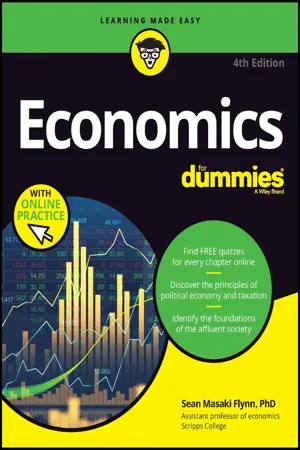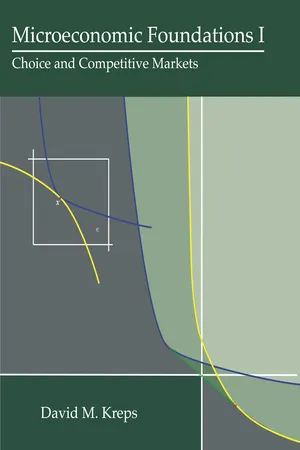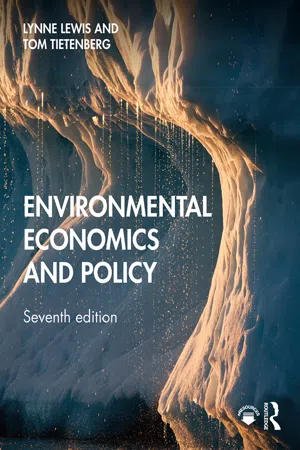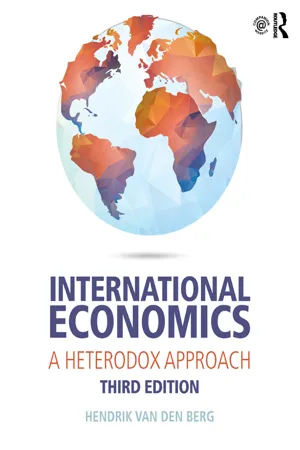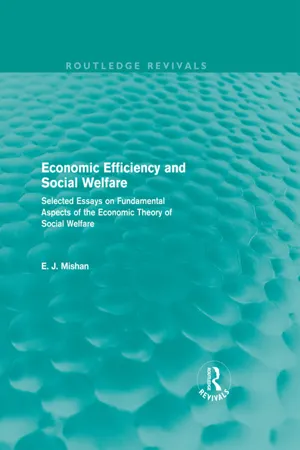Economics
Producer Surplus Formula
Producer surplus is a measure of the benefit received by producers when the market price is higher than the minimum price they are willing to accept for their goods or services. The formula for producer surplus is the difference between the actual price received by producers and the minimum price they are willing to accept. It is calculated as the area above the supply curve and below the market price.
Written by Perlego with AI-assistance
Related key terms
9 Key excerpts on "Producer Surplus Formula"
- eBook - ePub
Microeconomics
A Global Text
- Judy Whitehead(Author)
- 2014(Publication Date)
- Routledge(Publisher)
x , and what he would be willing to pay for this quantity rather than do without it’.The concept of the producer surplus may also be introduced. It may be defined loosely as the difference between what a producer actually receives for the sale of goods and what the producer would have been willing to receive rather than go without selling.The basic concepts of consumer surplus and producer surplus are illustrated graphically in Figure 4.1 . Graphically, at price P 1 the consumer buys quantity Q 3 . However, the consumer would have been willing to pay P 2 to acquire quantity Q 2 and P 3 to acquire Q 1 . This shows that when market price is in equilibrium at P 1 , the customer buys Q 3 but would have been willing to pay higher prices for the earlier units of the commodity. This implies that the consumer has gained from acquiring those earlier units at a price below what he/she was willing to pay for them. This difference is the consumer’s surplus represented by the darker shaded area.The consumer surplus may therefore be recognized as the area above the equilibrium price line and below the demand curve.Figure 4.1 Consumer and producer surplusOn the other hand, the producer surplus is recognized as the area below the equilibrium price and above the supply curve. The producer was willing to supply smaller quantities of the commodity x at lower prices than P 1 as shown by the market supply curve LT . Every unit sold at the equilibrium price P 1 that the producer would have been willing to sell at a lower price, benefits the producer. This gain on every unit up to Q 3 is summed to become the producer surplus and may be identified as the area LRP 1 - eBook - ePub
Economics For Dummies
Book + Chapter Quizzes Online
- Sean Masaki Flynn(Author)
- 2023(Publication Date)
- For Dummies(Publisher)
less than the $5 per gallon market price. You can see this by the fact that the supply curve lies below the horizontal price line up to the very last drop of the 1,000th gallon. The fact that they receive $5 per gallon for all of it despite being willing to produce it for less is the source of the producer surplus, which is represented by the area of the shaded triangle.Using the formula for the area of a triangle ( ), you can compute that the producer surplus in this example is $2,000. Producers are $2,000 better off after selling the 1,000 gallons of oil because the total cash they get from selling the 1,000 gallons is $2,000 greater than the minimum amount that they’d have been willing to accept to produce those units.Computing total surplus
The total surplus that society receives from producing the socially optimal level of output of a certain good or service is simply the sum of the consumer surplus and producer surplus generated by that output level.Figure 7-6 illustrates total surplus for a market in which the equilibrium price and quantity are, respectively, and . (If this graph looks familiar, that’s because it’s just like Figure 7-1 .)© John Wiley & Sons, Inc.FIGURE 7-6: Total surplus is the sum of consumer surplus and producer surplus.I’ve drawn the total surplus area so you can clearly see that it’s made up of consumer surplus (the vertically striped area) plus producer surplus (the diagonally striped area). The two are separated by the horizontal line extending from the market equilibrium price ($5).By again using the formula for the area of a triangle, you multiply to figure out that for this graph the total surplus is $16. The total gain to society of producing at this output level is $16.Contemplating total surplus
Total surplus is important because it puts a number on the gains that come from production and trade. Firms make things to generate a profit. People spend money on products because consuming those products makes them happy. And total surplus tells you just how much better off both consumers and producers are after interacting with each other. - eBook - ePub
- John H Hoag(Author)
- 2012(Publication Date)
- WSPC(Publisher)
P* – P2. If we continue up to the equilibrium output, we obtain a surplus.Definition 7.5: Producer surplus is the price the producer receives for the good minus the value the firm places on the good for all units sold.You can predict that the producer surplus is the area above the supply and below the price line. This is shown in Figure 7.4 .Figure 7.4 The producer surplus is the area above the supply and below the market price, as shown in the shaded area.Exercise 4. Suppose that we have a market and the firm is forced to produce more than X* at the price P*. What will the producer surplus be then?Exercise 5. Suppose that we have a market and the producer produces X*, but receives a price higher than P*. What will the producer surplus be then?As is true in the case of the consumer, there are externalities to consider. The cost to the firm is not necessarily the cost to society of that extra unit. What if there is an externality in production? Suppose that a steel mill produces both steel and air pollution. Now the cost to society of a ton of steel is both the cost of the resources needed to produce the steel as well as the cost to society of the air pollution, the increased cost of health care and the like. Obviously, we need a concept of marginal social cost.Definition 7.6: Marginal social cost (MSC) is the cost to society of producing an added unit of output.Section Summary:In this section, we have developed the ideas of consumer and producer surplus as well as the idea that price is a measure of the value of a good to the consumer and that marginal cost measures the value of the resources that go into the production of the good. Based on these definitions, we will develop a criterion for how resources should be allocated. That is the next task. - eBook - ePub
Microeconomic Foundations I
Choice and Competitive Markets
- David M. Kreps(Author)
- 2012(Publication Date)
- Princeton University Press(Publisher)
to the left of. The starting and ending points for this “area under the curve” also aren’t so clear, but when it comes to application, economists are primarily concerned with changes in producer surplus. So let me give the following as a formal definition:Definition 12.5. Fixing all prices except for the price p1 of some specific good, the supply “function” of which is given by (p1 ), the change in producer surplus when the price of the good shifts from to isThe superscripts n and o are mnemonics for new and old. Of course, in this integral, if price exceeds that of , you should understand this integral as being the negative of the integral with the upper limit being the higher price. What about values of p1 for which (p1 ) is not well defined? Since there are at most a countable number of such values, they don’t affect the integral. And we have:Corollary 12.6. The change in producer surplus is the sum of the changes in the profits of the firms that supply this good, resulting from the change in prices.Proof. Let f = 1, …, F ennumerate the firms that make up this industry, so that is the unique supply by firm f at price p1 , for all points p1 where is singleton. (We don’t worry about at prices where one or more firms have nonsingleton , as they don’t affect the value of the integral.) Therefore, the change in producer surplus when price changes from to isand by Corollary 12.4, the terms being summed on the right-hand side are just the changes in the profits of the firms, firm by firm.Warning
The warning I’ve been threatening to give can now be given. In many applications of the concept of producer surplus, the “industry supply curve” is estimated empirically. You must be careful about this. Imagine an industry filled with small, price-taking firms. In particular, imagine that one of the inputs to the production process used by the firms in this industry is supplied by another industry, and the supply of that input is upward sloping. To be clear, no one firm in this industry buys enough of this input to affect its price materially, and so all firms in the industry have competitive conjectures about its price: They believe that they can buy as much as they want at whatever is the prevailing price, and they choose their production plans to be profit maximizing, based on that belief. But on an industry basis, this industry buys enough of this factor of production so that if the level of output in this industry changes, demand for the factor input will increase enough to drive up its price. - eBook - ePub
- Lynne Lewis, Thomas Tietenberg(Authors)
- 2019(Publication Date)
- Routledge(Publisher)
Producer surplus = $800. Consumer surplus plus producer surplus = $1,600 = economic surplus. c The marginal revenue curve has twice the slope of the demand curve, so MR = 80 – 2 q. Setting MR = MC, yields q = 80/3 and P = 160/3. Using Figure 2.8, producer surplus is the area under the price line (FE) and over the marginal-cost line (DH). This can be computed as the sum of a rectangle (formed by FED and a horizontal line drawn from D to the vertical axis) and a triangle (formed by DH and the point created by the intersection of the horizontal line drawn from D with the vertical axis). The area of any rectangle is base ´ height. The base = 80/3 and the Height = P − M C = 160 3 − 80 3 = 80 3. Therefore, the area of the rectangle is 6400/9. The area of the right triangle is 1 2 × 80 3 × 80 3 = 3, 200 9. Producer surplus = 3, 200 9 + 6, 400 9 = $ 9, 600 9 Consumer surplus = 1 2 × 80 3 × 80 3 = $ 3, 200 9 $ 9, 600 9 > $ 800 $ 3, 200 9 < $ 800 $ 12, 800 9 < $ 1, 600 The policy would not be consistent with efficiency. As the firm considers measures to reduce the magnitude of any spill, it would compare the marginal costs of those measures with the expected marginal reduction in its liability from reducing the magnitude of the spill. Yet the expected marginal reduction in liability from a smaller spill would be zero. Firms would pay $X regardless of the size of the spill. Since the amount paid cannot be reduced by controlling the size of the spill, the incentive to take precautions that reduce the size of the spill will be inefficiently low. If “better” means efficient, this common belief is not necessarily true. Damage awards are efficient when they equal the damage caused. Ensuring that the award reflects the actual damage will appropriately internalize the external cost. Larger damage awards are more efficient only to the extent that they more closely approximate the actual damage - eBook - ePub
International Economics
A Heterodox Approach
- Hendrik Van den Berg(Author)
- 2016(Publication Date)
- Routledge(Publisher)
The concepts of producer surplus and consumer surplus let us put actual dollar figures on the gains to consumers and producers. For example, consumer surplus is the area of the triangle with a height of $6 (the difference between $18 and $12) and a base of 50 units, or $6(50)/2, which equals $150. Producer surplus is the area of a triangle with a height of $10 and a base of 50 units, or $10(50)/2, which equals $250. Thus, the existence of a market for T-shirts provides society with net welfare gains of $400.Figure 3.10 Producer SurplusFigure 3.11 Consumer Surplus3.5.2 From the HO Model to the Partial Equilibrium Model
Partial equilibrium models that look at single markets are convenient for illustrating the details of how economies are affected by international trade. However, individual markets are related to all other markets in the economy, and we should not forget that partial equilibrium models present a close-up picture of just one detail of the overall economy. A supply and demand model for a single market can be derived from the general equilibrium HO model that is used to represent the whole economy.Suppose that there are two economies in the world, Home and Away. Suppose, also, that Home and Away both produce two products, guns and butter. The economies of Home and Away are represented by the production possibilities frontiers (PPFs) and indifference curves in Figure 3.12 . The PPFs and preferences in the two countries are such that in the absence of international trade, the relative price of guns is half the price of a ton of butter in Home and twice the price of a ton of butter in Away. With free trade, the relative prices, represented by the price line pW , are equal to 1. The actual quantities produced and consumed at the self-sufficiency relative prices and the free trade relative prices provide points on the supply and demand curves for guns and butter.Let’s focus on the market for guns in each country. In a self-sufficient Home, the tangency between the indifference curve and the PPF is at point A, which is where the production of guns is equal to the consumption of guns, and guns cost half as much a ton of butter. With free trade, however, the relative price of guns rises to where it is equal to the price of a ton of butter. At the opportunity cost (price) of 1, supply exceeds demand by 30 guns. Similarly, at the opportunity cost (price) of 1, the demand for guns in Away exceeds supply by 30 guns, and the supply and demand curves in Away intersect at opportunity cost 2. This latter case is illustrated in the right-most supply and demand diagram in Figure 3.13 - eBook - ePub
Economic Efficiency and Social Welfare (Routledge Revivals)
Selected Essays on Fundamental Aspects of the Economic Theory of Social Welfare
- E. Mishan(Author)
- 2013(Publication Date)
- Routledge(Publisher)
It is, of course, possible to introduce some refinement into these various forms of producer’s surplus by reference to their spatial and temporal dimensions. A producer’s surplus arising from the differential earnings of a special factor as between firms in a single industry is, in general, smaller than the differential earnings of the factor if instead the comparison is made between this industry and others, and this in turn is smaller than the relevant differential as between regions. As for temporal comparisons, the longer the period considered the smaller the rent - a particular instance being quasi-rent accruing to a firm’s fixed capital in the Marshallian short period. But references to such refinements are incidental to the issue broached here; that turning on the validity of the concept of producer’s surplus which remains in use in economics. It has been and continues to be regarded as a surplus accruing to the firm or industry, a concept commonly believed to be symmetric with, and commonly used in conjunction with, consumer’s surplus. What is to be investigated then is the analytic status of producer’s ssurplu u s as a tool of partial welfare analysis especially in its application to competitive industry.Let us prepare the way by revealing an ambiguity in the conception of producer’s surplus arising out of an ambiguity in the construction of the supply curve.I
In his Principles of Public Finance , Hugh Dalton derives an old-fashioned formula [3, p. 48], the ratio of the elasticity of demand to that of supply, for the burden of an excise tax on a competitive good as between buyers and sellers. This ratio is reckoned to be approximately equal to the ratio of the loss of consumer’s surplus to the loss of producer’s surplus. But whether this upward-sloping supply curve is relevant to the long period or short period is not stated. If, as is likely, the long-period perfectly competitive supply curve was intended, a difficulty arises. For in comparative statics a zero (Knightian) profit accrues to all equally efficient firms ex hypothesi both in the pretax and post-tax long-run equilibria.3Similarly Mrs U. Hicks, in her volume on Public Finance - eBook - ePub
Natural Resources and the Environment
Economics, Law, Politics, and Institutions
- Mark Kanazawa(Author)
- 2021(Publication Date)
- Routledge(Publisher)
In other words, expenditures by consumers translate directly into revenues for sub shops. The net benefits of the sub shops are then the difference between their revenues and their total costs, or the lower triangle labeled PS. This measure of net benefits to the suppliers is known as producer surplus. So total net benefits equal the sum of consumer surplus and producer surplus. This figure thus shows a pretty equitable division of total net benefits between consumers and sub shops, because the areas of CS and PS look pretty comparable. I should add, however, that this question of the division of net benefits between consumers and producers in one single market is only a very small element of the entire issue of equity, which we will explore more fully in subsequent chapters. Question 2.8 : In the market for Jimmy John subs, demand may be expressed as: P = 15 – 0.01Q, where P is the price of a sub, and Q is the number of JJ subs sold. Supply may be expressed as: P = 5. Calculate the equilibrium price and quantity of subs sold. Calculate consumer surplus and producer surplus in equilibrium. Two important qualifications The market model is an extremely useful and powerful model that is used widely to (a) make predictions regarding market outcomes and (b) evaluate those outcomes. However, you should recognize that that model is based on certain assumptions that may or may not be satisfied in the real world. One key assumption is that there are many consumers and suppliers on each side of the market, engaging in vigorous competition. Another is that all firms are selling an identical product. A third is that each firm supplies a tiny fraction of overall market supply, so that no one firm can influence the price of the product - eBook - ePub
- Neva Goodwin, Jonathan M. Harris, Julie A. Nelson, Pratistha Joshi Rajkarnikar, Brian Roach, Mariano Torras(Authors)
- 2022(Publication Date)
- Routledge(Publisher)
The difference between these two curves at any point represents the gap between the maximum WTP of consumers and the production costs of suppliers. Some of this difference is “captured” by producers as profits, and the rest is consumer surplus. As long as the demand curve is above the supply curve, society receives net benefits by producing that unit of a product. However, if the supply curve is above the demand curve, then marginal costs exceed marginal benefits, and society would actually be worse off if that unit were produced and sold. Thus, as long as the demand curve is higher than the supply curve, it makes sense (from the perspective of social welfare) for society to produce each unit, to the point where marginal benefits equal marginal costs. Note in Figure 5.9 that this is true up to the equilibrium quantity of 700 cups of coffee. However, when the supply curve is higher than the demand curve, marginal costs exceed marginal benefits and society should not produce these units. Any production above 700 cups of coffee would decrease social welfare. In other words, the market equilibrium is the outcome that maximizes social welfare. We now test this result by considering what happens when the market is not allowed to reach equilibrium—when a regulation is enacted that sets a price different from the equilibrium price. 4.2 Price Ceilings Sometimes, governments intervene in markets to set price limits, either above or below the market equilibrium price. Somewhat confusingly, a price set below the market price is called a price ceiling (it is a “ceiling” because it establishes a maximum allowable price). price ceiling: a regulation that specifies a maximum price for a particular product Price ceilings are usually set with the goal of helping certain groups of consumers by keeping prices low. A classic example is rent control, which specifies maximum prices for rental units
Index pages curate the most relevant extracts from our library of academic textbooks. They’ve been created using an in-house natural language model (NLM), each adding context and meaning to key research topics.

